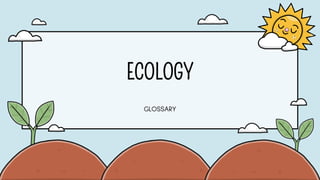
ecology for biology glossary of terms.pptx
- 3. A Aerobic A chemical process in which oxygen is used to make energy from carbohydrates (sugars). Anaerobic Anaerobic respiration is the process of creating energy without the presence of oxygen. Autotroph An autotroph is an organism that can produce its own food using light, water, carbon dioxide, or other chemicals. B Benthic The term benthic refers to anything associated with or occurring on the bottom of a body of water. The animals and plants that live on or in the bottom are known as the benthos. Boreal A boreal ecosystem is an ecosystem with a subarctic climate located in the Northern Hemisphere, approximately between 50° to 70°N latitude.
- 4. C Carnivore A carnivore, or meat-eater, is an animal or plant whose food and energy requirements derive from animal tissues whether through hunting or scavenging. Consumer Organisms that feed either directly or indirectly on producers, plants that convert solar energy into complex organic molecules. D Decomposition Decomposition or rot is the process by which dead organic substances are broken down into simpler organic or inorganic matter such as carbon dioxide, water, simple sugars and mineral salts. Detritus Accumulated organic debris from dead organisms, often an important source of nutrients in a food web.
- 5. E Ecosystem An ecosystem consists of all the organisms and the physical environment with which they interact. These biotic and abiotic components are linked together through nutrient cycles and energy flows. Environment The environment, is the complex of physical, chemical, and biotic factors that act upon an organism or an ecological community and ultimately determine its form and survival. F Food Chain A food chain outlines who eats whom, it is all of the food chains in an ecosystem and each organism in an ecosystem occupies a specific trophic level. Frugivore A Frugivore Is an animal that thrives mostly on raw fruits or succulent fruit-like produce of plants such as roots, shoots, nuts and seeds.
- 6. G Generalist Species that can live in many different types of environments, and have a varied diet are considered generalists. Grasslands The grassland biome is made up of large open areas of grasses. They are maintained by grazing animals and frequent fires. Types of grasslands include savannas and temperate grasslands. H Habitat A habitat is a place where an organism makes its home. A habitat meets all the environmental conditions an organism needs to survive. Halophile The halophiles, named after the Greek word for "salt-loving", are extremophiles that thrive in high salt concentrations.
- 7. I Ingestion Ingestion is the consumption of a substance by an organism. Intertidal On the shore between high and low tide lies the intertidal zone, where land and sea meet. K Kelp forest Kelp Forests are underwater ecosystems formed in shallow water by the dense growth of several different species known as kelps. L Limnology Limnology is the study of inland waters - lakes (both freshwater and saline), reservoirs, rivers, streams, wetlands, and groundwater - as ecological systems interacting with their drainage basins and the atmosphere.
- 8. M Morphology the study of the size, shape, and structure of animals, plants, and microorganisms and of the relationships of their constituent parts. N Niche The portion of the environment which a species occupies, defined in terms of the conditions under which an organism can survive, and may be affected by the presence of other competing organisms. Nocturnal An animal behavior characterized by being active during the night and sleeping during the day. O Omnivore An omnivore is an animal that has the ability to eat and survive on both plant and animal matter.
- 9. P Pathogenic Any organism that causing or capable of causing disease. Photic Zone Photic Zone is the top layer, nearest the surface of the ocean and is also called the sunlight layer. R Rain Shadow A rain shadow is a patch of land that has been forced to become a desert because mountain ranges blocked all plant-growing, rainy weather. Riparian A riparian zone or riparian area is the interface between land and a river or stream. S Saprophyte Saprophytes are the living organisms that live and feed on dead and decaying organisms.
- 11. T Terrestrial Living on land, as opposed to marine or aquatic. Tundra A tundra is a type of biome where tree growth is hindered by frigid temperatures and short growing seasons. U Upwelling The raising of benthic nutrients to the surface waters. This occurs in regions where the flow of water brings currents of differing temperatures together, and increases productivity of the ecosystem. Z Zooplankton Tiny, free-floating organisms in aquatic systems. Unlike phytoplankton, zooplankton cannot produce their own food, and so are consumers.
- 12. AMAZING!!